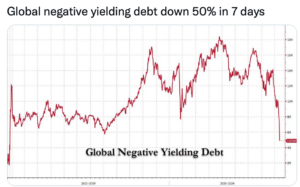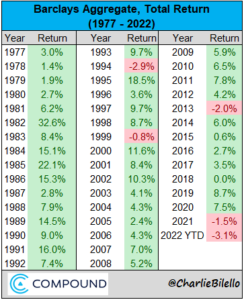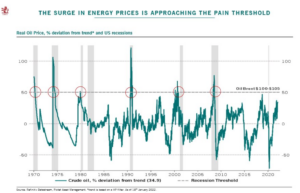1.Global Negative Yielding Debt -50% in 7 Days 40 Year Bond Bull Market Over?
Zerohedge

2.2022 has Already Equaled Worst Year Ever for Bonds
The Worst Year for Bonds in History? @Charlie Bilello
Entering this year, 1994 was the worst year ever for the bond market, with a loss of 2.9%.

But in a little over a mh, US Bonds are already down over 3% year-to-date.

3.Energy Prices Approaching Historical Levels that are Negative for Economy

From Michael Arouet
https://twitter.com/MichaelAArouet
4.Nasdaq Cheapest its been in 2 Years. But Still Most Expensive Since 2007
Bloomberg–Valuation doesn’t help greatly at times like this. After such a sharp move, what happens next will depend more on trading or technical factors than any measure of long-term value. This hasn’t stopped one statistic gaining currency, which is that the Nasdaq 100, after its selloff, was at its cheapest in almost two years. This was true, but misleading, as I hope this chart demtrates:

5.Facebook Holds 200day for Now on Long-Term Weekly Chart.. Buybacks History
FB chart last 200day break was Covid lows

1999-2022 StockCharts.com All Rights Reserved
Facebook huge buybacks in 2021 at highs. low buybacks during 2020 Covid lows

https://ycharts.com/companies/FB/stock_buyback
6.Three Mhs Ending Jan 31st. Nasdaq Emerging Cloud Index -33% vs. S&P -3.5%
Cloud Computing ETF vs. S&P Chart

1999-2022 StockCharts.com All Rights Reserved
Capital Group

7.An electric-plane pioneer has a plan to transform package delivery.
Washington Post-By Steven Zeitchik
With milli of packages clogging highways, start-ups are asking if there’s a better way. But their plans face some headwinds.
SOUTH BURLINGTON, Vt. One of the first packages in this country to cross state lines did so in 1913, when a farmer in southwest Iowa sent two dozen eggs 60 miles to a post office in Omaha. Most of them didn’t make it.
Today’s package is likely to traverse hundreds of miles and pass through an elaborate transit system (and arrive intact). But a few entrepreneurs say it could be made far more efficient with an innovation currently in development in this unassuming northwestern Verm suburb.
They are speaking of an airplane, a sleek electric craft that can whisk packages directly between warehouses without the need for runways or the hassle of highways. The plane offers a high-tech solution to a granular problem: a $5 million futuristic machine that can make that new shirt arrive a lot sooner. If it works, our package world, supercharged by the pandemic, would be greener and speedier. But problems ranging from scale to safety to Federal Aviation Administration certification mean plenty of eggs could also get broken along the way.

https://www.washingtonpost.com/technology/2022/01/31/innovati-evtols-electric-planes-packages/
8.Where Rents Bounced Back the Highest

https://www.nytimes.com/2022/02/03/realestate/where-are-rents-rising-the-most.html
9.2022 Set for Record Wedding Year 2.5m
The Wedding Report

10.The Dangers of Wanting to Finish a Task
Eva M. Krockow Ph.D.–The human desire to finish what you started can have dangerous cequences.
KEY POINTS
- Most people experience disproportionate pleasure when completing a task.
- This so-called “completion bias” can impair decision-making.
- A common cequence is to focus on completing trivial tasks instead of tackling bigger problems.
At what point does the pursuit of challenging goals turn into a dangerous obsession?
I have been asking myself this question ever since watching the mountaineering documentary “14 Peaks: Nothing is Impossible.” The programme follows Nepalese adventurer Nirmal Purja as he embarks on a wild mission to climb all 14 mountains of 8,000 metres or higher in less than seven mhs. Having no experience of mountaineering apart from the occasional recreational hike, I watched the documentary with fascination. I admired the strength, stamina, and tenacity of Purja and his team as they set out to change history with a daring new world record.
Not long into the programme, however, my admiration began to wane. On a journey that Purja called a mission possible, he fought brutal weather condition and almost lost his life in a 100-metre fall. Pushed for time, he continued despite avalanche warnings and life-threatening storms. He encountered fellow mountaineers dying in his arms and others surviving by the skin of their teeth. Not even his mother;s deteriorating health and subsequent hospitalisation could distract Purja from his all-important mission. He pursued the completion of his task with unrelenting determination, no matter the cost.
The documentary celebrated Purja’s perseverance, suggesting you can achieve anything as long as you persist. However, the more dead mountaineers Purja passed on the way, the more I began to question this message. By the end, his quest appeared dangerous, unnecessary, and plain reckless. While I was relieved to see him survive the difficult journey, I couldn’t help but think that he was lucky to tell the tale.
Why did an able mountaineer put his (and other people’s) lives at risk to complete an uncalled-for goal?
What Is Completion Bias?
Human culture values the completion of tasks. Students wouldn’t receive a certificate if they dropped out of university before sitting their final exams. Athletes would be met with disappointment if they aborted a run close before the finish line. (Also, dare I suggest that you, dear reader, would be frustrated if I had stopped writing this post halfway through?)
The importance of getting things done is deeply engrained in most people’s mindsets. Do you enjoy ticking items off your to-do list, and struggle to abandon tasks once you have started them? This phenomenon is called completion bias. Indeed, it appears that the bias is rooted in neurobiological mechanisms of the brain, with the experience of task completion leading to a release of the pleasurable chemical dopamine.
While completion bias can serve as a powerful motivator that may drive people to overcome difficult obstacles, it is important to beware of its dangerous side effects.
What Are the Dangers of Completion Bias?
What appears to be a useful driver of human behaviour and achievement can have surprisingly detrimental effects on daily decision-making. Examples include:
1. Avoidance of big tasks: With people constantly striving to get things done, many have a natural preference for focusing on easy tasks whose completion offers quick rewards. Recent studies found that people enjoy being able to tick trivial items off their to-do lists. Examples include sending a quick email or meeting invitation at work. And while it’s nice to keep a tidy inbox, this focus on mundane jobs can easily come our time. Ultimately, it may prevent us from tackling bigger challenges and tasks that really matter.
2. Irrational completion of tasks: In some cases, completion bias may go as far as driving people to finish futile endeavours that hold no personal benefits. A study on interactive decision-making found that some people were striving to reach the end of a task even though terminating early would have meant receiving bigger financial rewards. One of the participants explained her reasoning as follows: “My aim is to try and get all the way to the end just to feel like I’ve finished.”
3. Disproportionate risk-seeking: Thinking back to the mountaineering example from the beginning, a different danger is the compulsive pursuit of goals at all costs. People may lose sight of the negative cequences entailed in cinuing with a task and categorically reject the possibility of “giving up” or “quitting.” Indeed, this is such a common phenomenon in the context of mountaineering that the obsessive desire to reach the mountain peak has received a term in its own right: “summit fever.”
4. Losing sight of the journey: “It’s the journey, not the destination.” This famous quote by philosopher Ralph Waldo Emerson highlights another danger of completion bias. An obsession with the final goal may distract from valuable experiences along the journey. Personally, I have to remind myself of this fact when working towards mastering a new yoga pose. By blindly pursuing the final, perfect outcome, it is easy to miss out on the enjoyment of learning experiences along the way.
Can You Harness the Power of Completion Bias?
The human desire to get things done is not inherently problematic as long as we know how to manage it. One way to harness the bias is to learn from the results of behavioural studies and structure your to-do lists more efficiently. Research on task selection in office environments suggests that scheduling a few easy tasks for the beginning of the working day may help to boost motivation for bigger tasks to follow. This strategy may even increase personal satisfaction and overall performance. So why not start your day by getting some quick emails out of the way before moving on to tougher challenges?
If struggling to approach bigger, long-term goals, it may help to break them up. This could involve creating smaller and more manageable sub-tasks. As a result, you’d be able to tick off individual task components throughout your journey towards the larger goal. This is likely to leave you feeling more accomplished and motivated at every step of the challenge.
Finally, it is always worth remembering that abandoning a task does not equate to failure. Often, the deliberate choice to discontinue a mission can be a braver action than pushing through and continuing on a misguided quest.